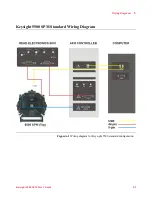
Electrochemistry
5
Keysight 5500 SPM User’s Guide
5-7
3
Push the spring-loaded pins up from the bottom to expose the pin
slots.
4
Insert the cell clamps into the slots and release the pins to hold the
liquid cell in place.
5
Place the pogo electrode into the hole in the wall of the liquid cell
nearest to the working electrode clamp.
6
Push the working electrode clamp up from the bottom and place the
end of the pogo under the clamp. Let the clamp spring back to hold
the electrode.
7
Use a multimeter to check for good conductivity between the sample
and the working electrode clamp.
8
Insert the counter and reference electrodes into the sample plate
block (
). Push the spring-loaded clamp forward from
behind, insert the electrode and release the clamp.
9
Position the electrodes so that they will make good contact with the
electrolyte but will not touch the sample substrate or each other.
10
Use a multimeter to check for good conductivity between the
reference electrode and sample plate clamp, and between the counter
electrode and sample plate clamp.
11
With the multimeter verify that the reference and counter electrode
are not shorted to another electrode or to the substrate.
12
Verify that the AFM probe or STM tip will pass through the
electrodes without any contact.
13
Fill the liquid cell enough to submerge the sample. Check for leaks
and reposition the cell if necessary.
14
Verify that the counter electrode feedback is turned off in the
software and that the potentials are set appropriately for the
particular experiment.
15
Connect the sample plate to the microscope using the 3-pin EC cable
connector of the EC/MAC Cable.
16
Load the sample plate onto the microscope.
17
Approach the sample.
NOTE
For improved conductivity an additional wire can be used to connect the
working electrode to the substrate through another hole on the liquid
cell.
















































